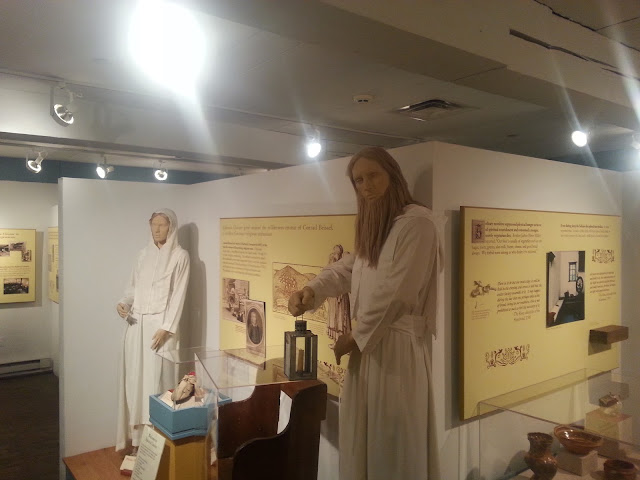The garments are one of the first item you see when you enter the exhibit. The garments look like a mix between Mormon underwear and puritan dress. The garment was also worn by the tour guide. The tour guide told us that the garment he had on was actually a revised like the tours that he was giving us. The garments represent the past life the cloister led. The garments were originally differentiated by gender. The first garments had a longer bib in the front for women and a shorter bib for men. Upon further research the historians found that the garment were universal to rid the sexual identities of the cloister. The idea behind the garments were that God was male and female and the humans were supposed to be one with God. To honor this ideology men and women were supposed to remain celibate and wait for God so they can become complete. The cloister used garments as a way to help with this because the garments covered up the outline of the body which, supposedly, cooled the burning fires of lust.
The author of Religious Objects in Museums: Private Lives and Public Duties, Crispin Paine, talks about the issue of what the visitor takes from the museum. The Cloister offered the class and I were two tours that day. The first tour was void of religion because not much information was available. When new information was found the tour was revised to include religious overtones that better explained the garments. The garments were not explained on the first tour so the point about the garments being a universal covering that suppressed lust would not have been mentioned.
One interesting point that Paine brings up on page 28 is the relationship that some people might have with the objects. There are not people that are directly linked to the cloister which eliminates that part of the visitor experience. However, because the cloister was a form of Christianity there was a worship house. As a visitor to the cloister I was very confused by the worship house of the Cloister because the worship house was void of all symbolism that is typically associated with a church. The first tour did not explain the difference between typical modern churches/worship spaces and neither did the second tour. The lack of symbolism was not addressed until I asked about the bare walls. The answer to this question was that Conrad Bissell, the founder of the Cloister, did not want any distractions during the worship service.
The garments are a way that shows the past but there is not anyone who still believes in that way of life anymore. The Cloister loses a little bit of meaning on that aspect because there are not any realties that can codify the experience and further explain some of the present oddities so that visitors can get the full story.
1 C. Paine, Religious Objects in Museums: Private Lives and Public Duties (New York, New York), 28.



No comments:
Post a Comment